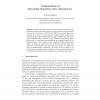114
click to vote
ACL
2012
13 years 2 months ago
2012
Many semantic parsing models use tree transformations to map between natural language and meaning representation. However, while tree transformations are central to several state-...
120
click to vote
CORR
2011
Springer
14 years 7 months ago
2011
Springer
We introduce streaming tree transducers as an analyzable and expressive model for transforming hierarchically structured data in a single pass. Given a linear encoding of the inpu...
110
click to vote
ACL
2010
14 years 10 months ago
2010
Weighted tree transducers have been proposed as useful formal models for representing syntactic natural language processing applications, but there has been little description of ...
109
click to vote
ACL
2010
14 years 10 months ago
2010
A characterization of the expressive power of synchronous tree-adjoining grammars (STAGs) in terms of tree transducers (or equivalently, synchronous tree substitution grammars) is...
IANDC
1998
14 years 12 months ago
1998
ed tree transducers are abstract models used to study properties bute grammars. One abstraction which occurs when modeling attribute grammars by attributed tree transducers is that...
103
click to vote
IANDC
2008
15 years 10 days ago
2008
Abstract. Unfortunately the class of transformations computed by nondeleting and linear extended top-down tree transducers [Graehl, Knight: Training Tree Transducers. HLT-NAACL 200...
NAACL
2004
15 years 1 months ago
2004
Many probabilistic models for natural language are now written in terms of hierarchical tree structure. Tree-based modeling still lacks many of the standard tools taken for grante...
124
click to vote
EACL
2006
ACL Anthology
15 years 1 months ago
2006
ACL Anthology
We place synchronous tree-adjoining grammars and tree transducers in the single overarching framework of bimorphisms, continuing the unification of synchronous grammars and tree t...
105
click to vote
DLT
2008
15 years 1 months ago
2008
Extended multi bottom-up tree transducers are de
ned and investigated. They are an extension of multi bottom-up tree transducers by arbitrary, not just shallow, left-hand sides of ...
107
click to vote
PODS
2010
ACM
15 years 5 months ago
2010
ACM
A generalization from string to trees and from languages to translations is given of the classical result that any regular language can be learned from examples: it is shown that ...





